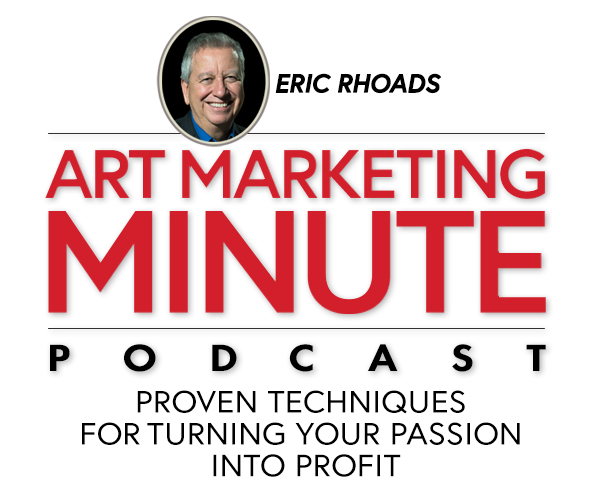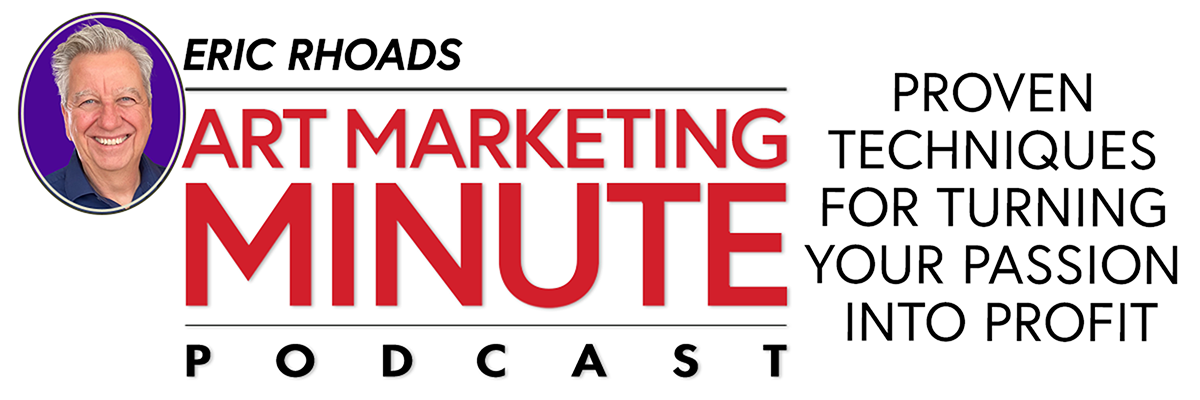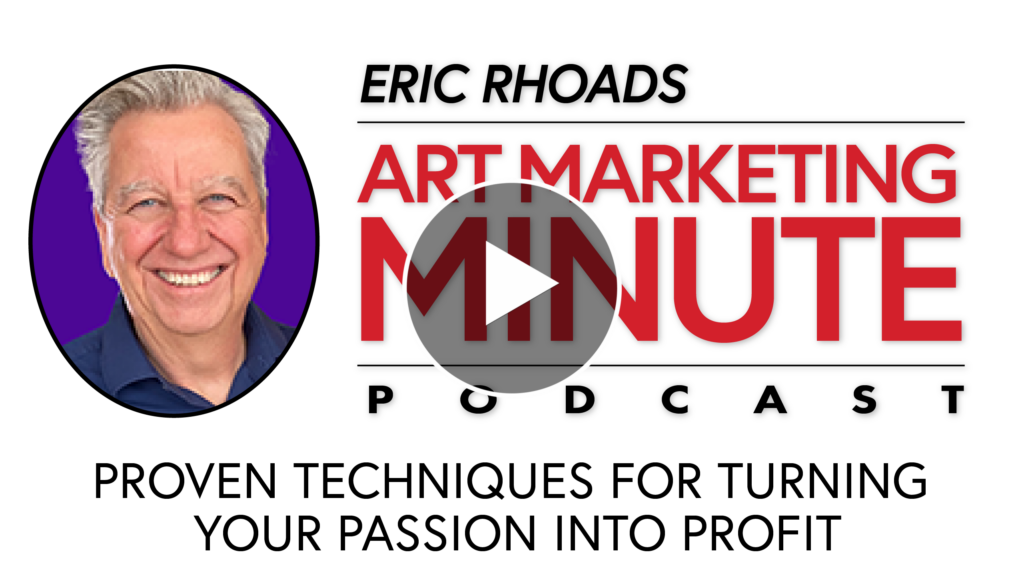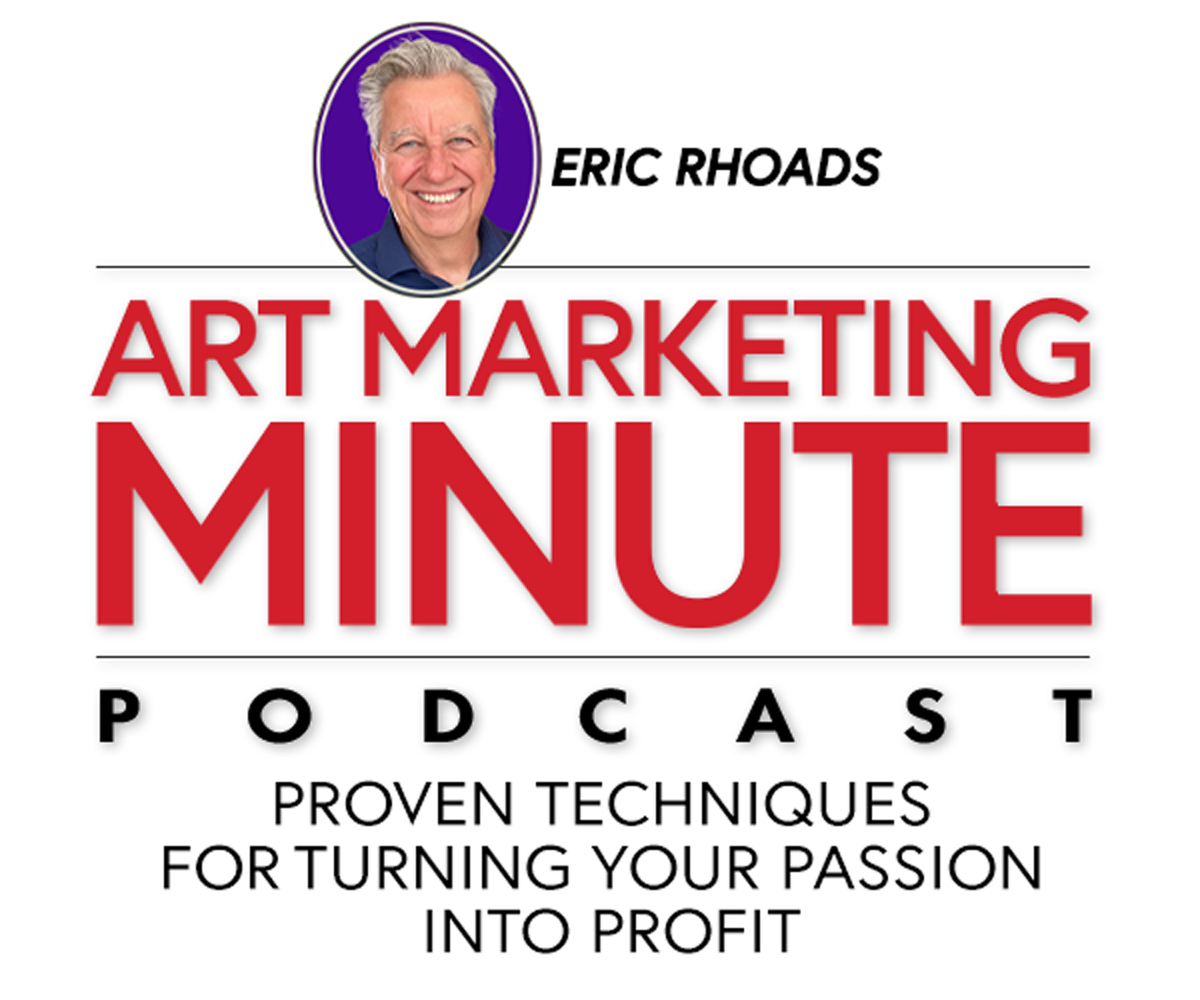Art Marketing Minute Podcast: Episode 107
In the Art Marketing Minute Podcast, you’ll learn how to sell your art, how to market your paintings, and everything else you need to know in order to have a successful art career. Each episode answers questions from artists by host Eric Rhoads, author of “Make More Money Selling Your Art,” publisher of several art magazines and newsletters, and author of ArtMarketing.com.
In this Art Marketing Minute, Eric Rhoads answers the questions: “How do you negotiate an art show?” And, “How long does it take to know if my website updates are working?”
Have a question about how to sell your art? Ask Eric at artmarketing.com/questions.
Listen to the Art Marketing Minute Podcast: Episode 107 >
Submit Your Art Marketing Question:
What questions do you have about selling your art? Email Eric today at [email protected] (include your name and where you’re from) to hear your question answered on an upcoming Art Marketing Minute Podcast.
FULL TRANSCRIPT of the Art Marketing Minute:
DISCLAIMER: The following is the output of a transcription from an audio recording of the Art Marketing Minute. Although the transcription is mostly correct, in some cases it is slightly inaccurate due to the recording and/or software transcription.
Announcer:
This is the Art Marketing Minute with Eric Rhoads, author of the Amazon best selling book, “Make More Money Selling Your Art.” In the marketing minute we answer your questions to help your art career brought to you by artmarketing.com, the place to go to learn more about marketing. Now, here’s your host, arts magazine publisher, Eric Rhoads.
Eric Rhoads
Okay, well the art marketing minute is all about answering your questions you can upload, you can shoot a video and upload it or and send it to us or you can go to our artmarketing.com/questions and you can automatically shoot a video there and send your video questions in or email to be [email protected]. And we try to answer questions for you. So already what is our first question today?
Amandine
My first question is from Joanna. So it says how would you go about negotiating a weekend show with a neighborhood association or apartment complex. I live in a complex in a high end neighborhood with lots of well to do folks. And I’m thinking of working with the apartment management to get a show in the lobby for a weekend. I’m trying to envision a successful negotiation with a win win for them and me and don’t know how to script the conversation, what questions to ask what I should expect for rejections, etc? And how to confidently go in and ask for a great deal.
Eric Rhoads
Well, Joanna, that is a terrific question. And I’ve got a lot of different answers. You may not like some of them. The first question you always want to ask yourself when you’re dealing with anything to do with marketing or a show or otherwise, is what are my expectations? What do I want to get out of this? Why do I even want to do this, you have a reason in the back of your head? Why you want to do this show in this apartment building and, and you know, maybe there’s a subconscious level thought about well be kind of nice to be seen by my neighbors. So they know that I’m this terrific artist. Or maybe you’re saying well, I just want to sell more art. But you want to make sure that you have a very specific goal in mind with everything that you do. I try for instance, if I’m going to do anything, I asked myself, What if I could only accomplish one thing? What is the one thing that I want to accomplish? So for instance, if I’m on I’m interviewed on somebody else’s podcast, then I’m going to try to promote one particular thing I might talk about a lot of things, but let’s say I want to get their email addresses or something, then that’s the one thing so you’re doing a show. And if you do a show at your apartment complex, I don’t know if this has got 5000 people or 10,000 people or 200 people or 50 people, you say it’s high end, but it seems to me to be narrow. Now I don’t want to burst your bubble, but it does sound narrow. And so when when you’re talking about something narrow, you might be limiting your prospects. Now you might be telling yourself our heads play an awful lot of a role in what we do. You might be telling yourself Well, I’ll start here, get a little experience here and try it with the apartment complex before I do anything more. And that’s okay. But make sure you first stops, okay, what do I want to accomplish? If if you say I want to make this about selling paintings, then that’s fine. Now, when now let’s take your goal to the next step, if you want to sell paintings, how many paintings Do you want to sell? What will you continue to be? What will you consider to be a success? You know, anytime you do a show, there is a huge amount of effort and work that’s involved in that show. And, you know, framing and time and everything else. And so you’re going to have a minimum amount of expense that you’re going to have to cover. And so you know, you might say to yourself, Okay, I have to make a minimum of $2,000. Or maybe it’s a minimum of $5,000. If you go in understanding what that looks like, you’re gonna have a lot more success that way. Because you have to, you know, what, if you do the show, and, and you don’t sell anything, well, that’s very possible. But if you if you know that you’ve got a nut, you’ve got to hit let’s say, you know that my minimum is going to be $5,000, then you’re going to work like crazy to make sure that you hit that $5,000 mark, you know, things aren’t selling, you might start discounting or you mark smart, you know, cutting deals or, or something to try to draw people back to you to get them in. Now, the downside of an apartment building thing is, maybe people want to do it, maybe they don’t, it depends on the nature, if your apartment building does stuff like that, if they have community aspect, it’d be nice to have a cocktail party, show your paintings and so on. But you may or may, if it’s an apartment building, it’s a narrow amount of people, and you may not be able to get as much success there. On the other hand, if you were to do the same thing for a month, in a popular restaurant in town, you might get 10 times as many people or 100 times as many people volume, you know, and if you do it at the country club, or you do at a high end restaurant where you know, people have money, then you increase your odds, you always want to look for how can I get the biggest possible audience, it’s good to have targeted audiences, but big audiences within targets are always nice. And so start there. In terms your question about negotiating with the apartment complex? The first question you have to ask is what’s in it for them? Why would they possibly do this? Is this something that they care about? While they may have something in their head about? Well, we want to do things so that people in the apartment complex think that they’re doing things for them. So it’s a good place to live? They’re going to want to renew their leases. So maybe they do cocktail parties, maybe they do gatherings? Maybe they do little things like this. And so in that case, that’s the reason that’s why they want to do it. But there may be, there may be other things they might be looking at to say, Why should we bother? What’s in it for us? Well, you might say, Okay, well, will I give up some of the income, you know, if I give up 10, or 20, or 50%, to them for housing the show for you, you would have to do that at an art gallery. And so why not do it? In a case like that, now, that amount of money may not be, you know, if it’s a big apartment complex, it’s only going to result in a few $1,000. To them, they may not care, but trying to understand that. And now when you have your meeting, first off, what I would suggest you do is you put together a little bit of a presentation, not a big one of the three or four slides on your iPad, and you say, Listen, you know, I want to show you what I have in mind, here’s some samples of my artwork. This is kind of what I have in mind, this is what I want to do, this is why it’s going to benefit you. And then then rehearse that a few times. And when you get together with them, what you want to do is start out the dialogue and start instead of starting pitching, asking them say listen, you know, I’m a local artist, I’ve got an idea, I’m gonna pitch you, but what are the most important things to you for this apartment complex? What do you need the most and, and they might say, you know, our biggest problem is getting people to renew their leases. Or they might say, you know, our biggest problem is, nobody feels connected. When they tell you these things, then you can lift them out in your conversation and repeat them back to them. So, you know, one of the reasons I designed the search show is because you’re going to make people feel more connected, when they make they feel more connected, they know their neighbors, they’re going to be less likely to want to leave, they’re going to want to be more likely to renew their leases. You didn’t have to build that into your presentation. But now that you’ve asked the question up front, you now know what’s important to them. So then build that into your presentation. In terms of getting yourself ready expecting rejections while you know you’re going to get rejections. It’s not a big deal. It’s a part of life. Just ask him those questions and then you know, you’re not going to have confidence because confidence is something that we all we all lack. In some cases, just go in there and be brave and just say Hey, I want to meet with you and they’re not going to bite. If they don’t want to meet, they’re going to tell you they don’t want to meet. And then you know, you can always follow up with an email, say, well, here’s my eat idea. But if you can get it in person, or at least on a zoom call, you’re going to be better off. So think in terms of what is my objective? What do I want to sell? What are they gonna want out of it? And then, you know, why would they possibly do this? What’s in it for them? Now, just get out there and do it. I think that’s the most important thing. Now the next question comes from David Wood. Amandine, what’s the question?
Amandine
The question is, how long can I expect to wait to see whether the design of a website is working in bringing traffic and sales? I notice, a lot of visitors don’t really go beyond beyond the first page. My website includes both art for sale and teaching art. I feel it is a well organized and interesting sites. Also, is it a good idea to have items in the online shop that have sold?
Eric Rhoads
Okay, well, that’s a really terrific question. Thank you for that, David Wood. So the one thing I want you guys to get out of your head is that a website is gonna make you rich, you know, I’ve had people contact me and say, you know, I’m going to build a website, and I’m going to, I’m going to do all these great things with a website, and I’m going to get all this traffic, and I’m going to sell all these paintings. It’s not the case. Now you need a website, I’m not suggesting you don’t, you don’t have to have a website these days, you can, you know, because of Facebook, and Instagram, and so on. They’re also important for you, but you should have a website, if you’re a professional artist, and you’re selling your work. But hear me out, the thing that is going to drive your website success, or your success with a website is not the website itself, yet, what’s going to drive success is how you drive people there. And imagine, and a lot of people won’t understand this reference, because it’s an old, old person’s reference, I suppose. But, you know, back when there were phone booths in the city of New York, phone booths, were actually on the corners, right? They had attached to it a phone book, which was about five or six inches thick, it was a big book, and every page had 2000 names on it. And you would flip through and you know, look under roads, and then find Eric Rhoads and then it would have my address and my phone number. And then you’d call the phone number. Well, I mean, having a website, you know, there are probably billions of websites today. And having a website is kind of like getting your name in the phone book, and nobody cares, it doesn’t matter. It only matters if they’re trying to find you. And the only reason they’re trying to find you is if you give them reason to try to find you. So your design of your website matters. And I will touch on that in a minute. But first off, think in terms of if I have a website, what am I going to do to get people there? How do I do that? Well, a lot of that is going to be through your advertising, through your direct mail, through your newsletter, through your promotions, through your social media, things like that. So you’ve got to have a strategy to drive people there. Now websites are all over the map, I went to a artists website the other day, and it looked like he hadn’t touched it for 30 years, it still said click to enter, which was kind of what they did in the early stages of the websites, you know, you want to you want to make sure you’re paying attention. I go to artists sites all the time, because I’m looking for artists for the magazines. And I visit artists sites, and they haven’t updated their their website and three years, they don’t have their current paintings on it, you know, the websites clunky it doesn’t work, right? You got to make sure all those things happen. You also have a single focus. Now you talked about wanting to sell art, but also wanting to sell workshops 80% of your workshop 80 Excuse me, 80% of your website needs to be focused on the thing that is most important to you. So if it’s selling art than 80% of your time, and focus needs to be about that, you know, you can have a little slide at the bottom that says you know, workshops also available. But you know, you’re talking about selling art. I have had so many conversations with my advertisers over the year one called me said You know, I’m I know I’m getting website visitors after I started advertising because I’m tracking the numbers, but nobody’s buying anything. And I said, What are you trying to sell? And she said, Well, I’m trying to sell commissioned portraiture. So I went to the website and I looked at it I couldn’t find anything about commission portraiture and then I knowing I’m looking for it I dig around. I finally after 10 minutes I find it and it’s buried. It’s hard to find and I said you know your advertising commission for portraiture, the first thing they should see on your website is commissioned portraiture. And if you’re, you know if you’re one of the two See if you’re advertising landscape, you want that landscape, not just a landscape, the one that’s advertised needs to show up for that month or two months on the front of your webpage. Even if it’s sold, you can say, you know, this painting is sold, but you click here to see three others that are similar to it, you want to focus on what matters most. Okay? So I think websites are really important. And they’re a great way to get names, and we all need names, websites are a great way to say, you know, I’m offering up a free ebook of the 100 best paintings I’ve ever done. Or if you’re promoting workshops, I’m offering up you know, 10 really great painting tips from me, the artists, and just click here to get this ebook, you’re getting their email address, then you can add them with their permission, you can add them to your newsletter list, now you have a way to reach out to them to talk to them to communicate with them. So you’re not waiting for them to come to your website. Websites need to be there, you need to drive people there. There are organizations that make websites that you can buy from anywhere or their organizations to make websites that are specifically for artists. And those are also good, and they have some programs they can use to drive people to websites, so they can help you a lot. But you want to make sure that you are focusing on what is my purpose, everything you always ask is What am i What is my purpose? What’s my primary focus? And how do I make sure that that focus is front and center in front of everybody? And then how am I going to drive people there? Now you ask another question, and that is about your online shop. Should you show things that are sold? You know, I think so. And I think there’s a psychology of it. If you see red dots, and it says sold, it says it’s called social proof. It’s what other people are doing. They’re buying from you, it shows other people are buying from you. So you know, if you have a few red dots on there that says oh, there’s sell like, I’d better pay attention and maybe find something I want before it’s sold. So I think it’s a good idea. Now, if most of them are red dots, and they’re getting in the way of putting the work up front, put them you know, put a few red dots on the page, and then move them to the back, you know, and so that every page has a few red dots, but go ahead and show those sold items. The other thing, by the way, is it’s okay to show your prices a lot of people say call for prices. But that’s I think is the biggest mistake in the world. Because, you know, those of us in this in this day and age, we don’t you know, we’re on a website, three o’clock in the morning, when we can’t sleep and you know, we might be in the mood to buy something. I buy stuff at three o’clock in the morning all the time. If I don’t know the price, and I can’t click on it to buy I’m not going to pick up the phone call. I mean, there are people who will but I’m not one of them. So I think you should focus on that. Anyway, I hope this has been helpful. That’s the marketing minute. I want to encourage you to submit your questions at art marketing comm slash questions. All right.
Well, this has been the art marketing minute with me. Eric Rhoads. My goal in life is to eliminate the idea of the starving artists to help your dreams actually come true. So if you want to submit questions, simply email [email protected]. And to learn more about marketing ideas, you can visit Artmarketing.com. Thanks for listening.
How to Submit Your Art Marketing Questions: What questions do you have about selling your art? Email Eric today at [email protected] (include your name and where you’re from) to hear your question answered on an upcoming Art Marketing Minute Podcast.
> Visit EricRhoads.com (Publisher of ArtMarketing.com) to learn about opportunities for artists and art collectors, including:
- Art retreats
- International art trips
- Art conventions
- Art workshops (in person and online)
- And more!



